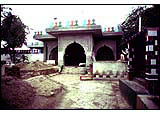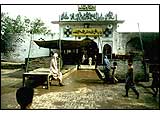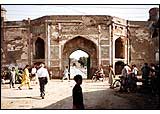 |
Area
of the Anguri
and Inayat Gardens
|
|
|
|
|
|
 |
Traveling
east along the present alignment of the Grand Trunk, beyond Begumpura
lies the village of Baghbanpura, the "Village of Gardeners." Baghbanpura
is the settlement most clearly associated with, and dependent
upon, a Mughal garden. It served Shah Jahan's Farah Bakhsh and
Faiz Bakhsh gardens, which later came to be known as Shalamar.

This
village of gardeners was presumably made up of families of malis
(gardeners) and other site attendants, traders, and artisans.
They initially served Shalamar garden, but subsequently worked
around other gardens that were built in the area, including the
Anguri (grape) and Inayat (providence) gardens,
fragments of which survive just south of the Grand Trunk Road
today. This village was not located in a prime horticultural area,
from the standpoint of soils or vegetation. Instead, it lay at
the best site for a Mughal garden in Lahore: a sharp escarpment
created by the scouring of the Ravi River at some point in the
sixteenth or early seventeenth century.

|
 |
The
Shrine of
Shah Abdul Ghani
|
 |
|
|
|
Along
that terrace lie tombs, graves, and gardens from the village of
Kot Khwaja Saeed to Bhogiwal, Bhagbanpura, and beyond. Kot Khwaja
Saeed has a tomb-garden attributed variously to Dara Shikoh, Prince
Parvez, or to the sons of Parvez. Bhogiwal has the tomb-garden of
Mian Khan (d. 1671), later known as the Raja Bagh after Raja Sochet
Singh, which is distinguished by the unusual black marble cladding
on its plinth. To the east is the shrine of Shah Abdul Ghani, the
original construction of which was attributed to Dara Shikoh but
which has been rebuilt many times since.
 |
The
Shrine of
Madho Lal Hussain
|
 |
|
|
|
Other
prominent Mughal period monuments in the area include the mosque of
Khwaja Ayaz and the shrine of Madho Lal Hussain. Hussain is renowned
for his Punjabi mystical love poems. |
|
|
Original
Main Entry
to Shalamar Garden
|
 |
|
|
|

At the base of this river terrace, northeast of Madho Lal Hussain,
runs the old road that served as the main entry to Shalamar
garden. Although metropolitan Lahore has expanded far beyond
this road and suburban garden outpost of Mughal times, the exuberance
of bazaars, shrines, and schools in Baghbanpura today gives a
sense of at least some aspects of this historic "Village of Gardeners."
|
|
|

Today only a few dozen gardeners tend the plots that were once
manicured by hundreds of malis (gardeners) who lived in
Baghbanpura. Although they remember some stories about the descendents
of the malis of Shalamar, none of the gardeners employed there
today is said to be related to the gardeners of Mughal times.
|
 |
 |
 |
 |
|